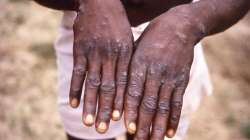Kerala: SOPs issued for isolation, sample collection, treatment of monkeypox cases
Kerala monkeypox cases: The first case of monkeypox, a rare but potentially serious viral illness, was reported in the Kollam district of south Kerala on July 14.

Kerala monkeypox cases: The Kerala government on Wednesday issued standard operating procedures (SOP) for isolation, sample collection and treatment of those infected or showing signs of monkeypox.
The state government on Tuesday started testing for monkeypox infection at the Alappuzha NIV with testing kits brought from Pune NIV. India had on Monday reported a second confirmed case of monkeypox from Kerala's Kannur district.
It was a patient, who arrived in Kerala on July 13, was a native of Kannur in north Kerala and was undergoing treatment at the Pariyaram Medical College there.
The first case of monkeypox, a rare but potentially serious viral illness, was reported in the Kollam district of south Kerala on July 14. He is currently undergoing treatment at the Government Medical College Hospital, Thiruvananthapuram.
Both their samples were sent to the National Institute of Virology (NIV), Pune, and they tested positive for the virus.
In a release, Kerala Health Minister Veena George gave details of the SOP which is to be followed by all private and government hospitals.
- Any person who has travelled in the last 21 days to a country where monkeypox has been reported and is having red spots on the body along with one or more of the other symptoms, like fever, headache, body ache should suspect infection by the virus
- The risk of infection is high through close physical or direct skin-to-skin contact or sexual intercourse with an infected person or by touching their bedding or clothing. Anyone falling in these categories would come in the primary contact list. The infection will be confirmed through a PCR test
- Suspected and probable cases of monkeypox are to be treated separately and in isolation and the District Surveillance Officer (DSO) should be informed immediately
- Samples should be collected as per the protocols laid down for the same by the National Institute of Virology (NIV) and the DSO would be responsible for sending the same to the lab
- Referrals from private hospitals to government facilities should be on patient request and only critically ill patients from state-run hospitals with isolation facilities should be referred to medical colleges
- While transporting infected persons to a hospital or from one medical institution to another, a PPE kit, N95 masks, gloves and goggles should be worn by the health professionals and the patients too should wear an N95 or triple layered mask and any wounds on their bodies should be covered
- After patient delivery, the ambulance and equipment therein should be disinfected and patient items like clothing should be disposed of according to the guidelines
- Confirmed cases of monkeypox should be managed as per the Centre's guidelines exactly and in case of any doubt regarding treatment, the state medical board should be consulted
- As all international airports in the state have thermal scanners, anyone showing signs of fever would be examined for red spots by a medical team and if such signs are found, they will be transferred to the nearest hospital with isolation facilities and the DSO would be informed about the same
- Health workers have been directed to monitor those in the primary contact list for 21 days for any symptoms by calling them over the phone and recording their temperature twice a day
- The health worker or nurse in charge of monitoring should visit the house of the contacts periodically to ensure they follow the guidelines
- In case the primary contact person has fever, they should be immediately isolated and if red spots appear, their samples should be sent for monkeypox testing
- Those in the contact list who are not showing symptoms should not donate blood, cells, tissue, organs, or semen
According to the World Health Organisation, monkeypox is a viral zoonosis (a virus transmitted to humans from animals), with symptoms similar to those seen in the past in smallpox patients, although it is clinically less severe.
With the eradication of smallpox in 1980 and the subsequent cessation of smallpox vaccination, monkeypox has emerged as the most important orthopoxvirus for public health.
(With inputs from PTI)
Also Read | Expert believes monkeypox can be fatal for children, WHO says South-East Asia on 'alert'